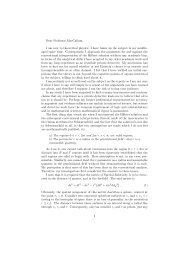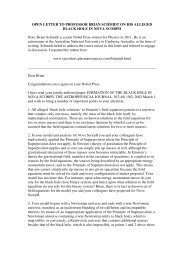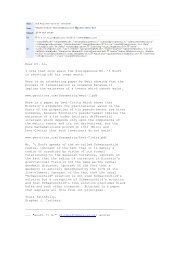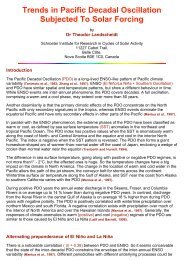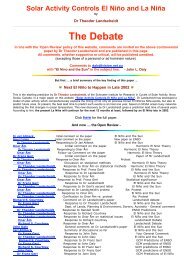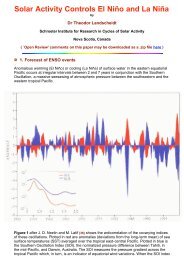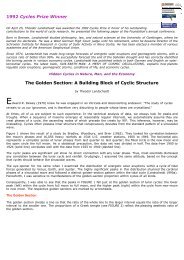Sun-Earth-Man - PlasmaResources
Sun-Earth-Man - PlasmaResources
Sun-Earth-Man - PlasmaResources
Create successful ePaper yourself
Turn your PDF publications into a flip-book with our unique Google optimized e-Paper software.
7 0 SUN-EARTH-MAN: A MESH OF COSMIC OSCILLATIONS<br />
YEARS<br />
Figure 31: Unsrnoolhed values of the data presented in Figure 30 Epochs of Jupiter-CM con]unctions are indicated<br />
bv black hiangles. " Open . dew mark mend harmonics of coniunction wdes. The res~ective cwchs mincide with<br />
ertrerna m the r a variation. ~ ~<br />
The JU-CM-CS effects seem to have left their mark still in other climatic<br />
features. The longest records of ice in the western North Atlantic are derived<br />
from the yearly counts of the number of icebergs that pass south of latitude<br />
48" N to affect the shipping lanes.ln These counts are quoted in terms of the<br />
Smith-index which provides a scde from -5 to +5. The time series covers the<br />
period 1880 to 1976. As the counts refer to higher latitudes, the position of the<br />
crucial epochs in the sine wave should show no phase shift. This turns out to<br />
be true. The test of both groups, processed in the same way as the German,<br />
England and Wales, and U.S. rainfall data, yields the following result: n, = 56;<br />
f, = 5.32; s, = 7.17. n, = 40; i, = 2.68; s, = 3.37, t (df=&Q) = 2.41; P = 0.009.<br />
The rejection of the null hypothesis is again justified at a high level of<br />
significance.<br />
XI!. COSMIC INFLUENCE ON WEATHER 7 1<br />
Temperature opens a further field of replication. F. Baur'05 established a time<br />
series of yearly temperature averages (OC) based on the respective means of<br />
the stations Utrecht-de BiIt, Potsdam, Basle, and Vienna. With extensions<br />
taken from the "Berliner Wetterkarte", the series covers the period 1851-1983.<br />
The sine wave method, as applied to the central European rainfall data, gives<br />
the following values: n, = 77; P, = 0.463; st = 0.619. n2 = 55; f, = 0.217; s, =<br />
0.3. t (df=118) = 3; P< 0.002. This result is again highly significant. Yearly<br />
mean temperatures in central England for the period 1851 - l976lm offer<br />
occasion for another replication. The result is significant, but less striking: n,<br />
= 69; f, = 0.293; s, = 0.382, n, = 56; f, = 0.196; s, = 0.274. t (df=123) = 1.65;<br />
P = 0.05. As was to be expected, there are no indications of a phase shift.<br />
Phases -rr radians (180") point to series of years showing little contrast in<br />
temperature, whereas JU-CM-CS epochs are characterized by sequences of<br />
alternately hot and cold years. An analysis of annual average temperatures of<br />
the Northern Hemisphere for the period 1850 - 1978 yielded no significant<br />
difference of the means of groups formed with respect to epochs of JU- CM-CS<br />
events. This may be due to phase differences in different geographical<br />
latitudes that cancel out.<br />
These are the first results in the field of solar-terrestrial relations regarding<br />
weather which cover large areas and long periods consistently. Moreover, they<br />
are accessible to prediction because they are based on configurations of cosmic<br />
bodies in the solar system that can be computed. The results of this new kind<br />
of interdisciplinary approach, which integrates astrological views and modem<br />
science, should be intriguing enough to induce experts in the different fields<br />
involved to follow the trace outlined in this study.



